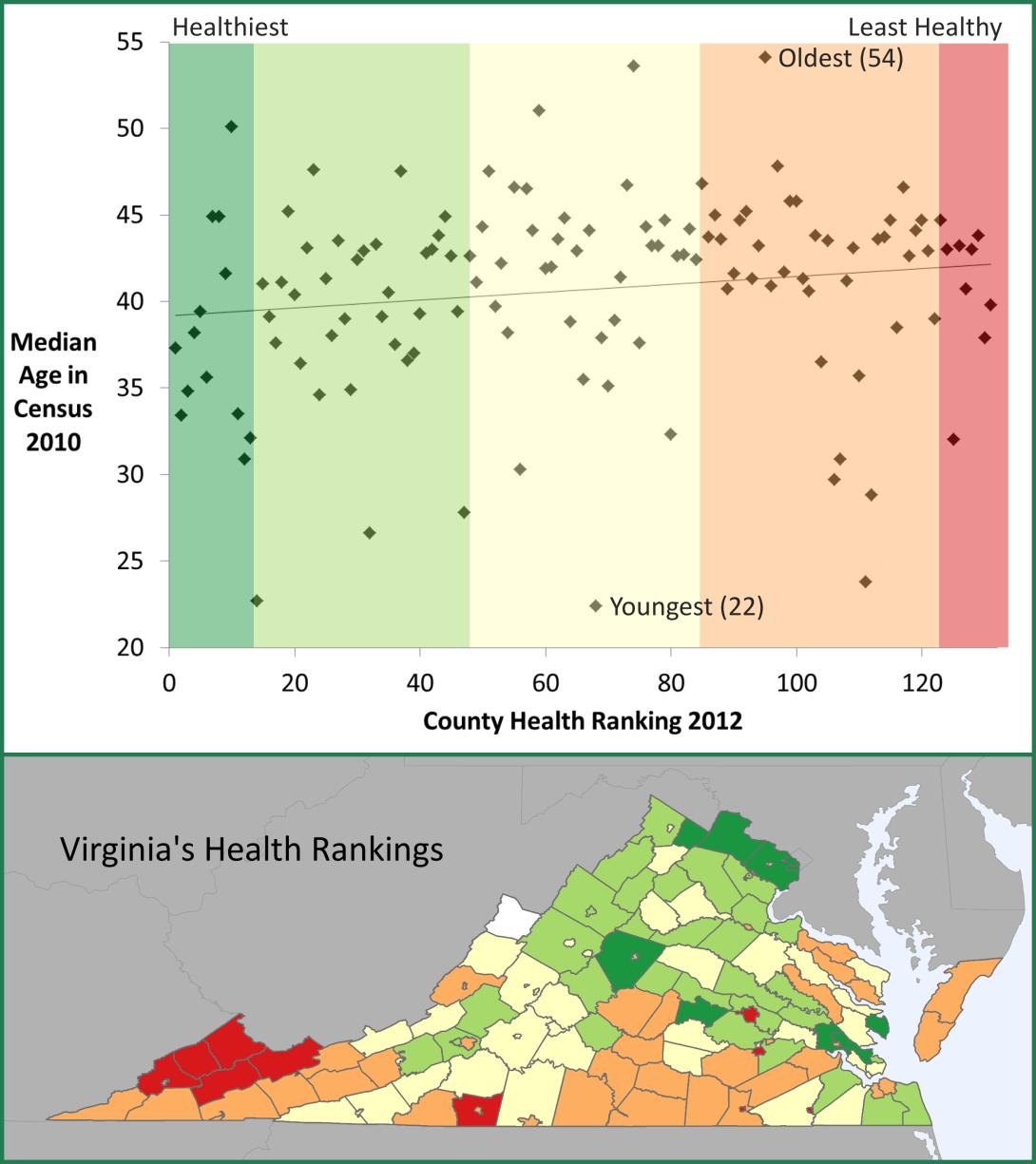Health and Age in Virginia’s Localities
Earlier today our office released my latest Stat Chat publication, Virginia’s Health Rankings. The publication presents data from the America’s Health Rankings and County Health Rankings & Roadmaps projects. These data sources include annually updated health rankings of the 50 states and of all counties in the U.S, as produced by the United Health Foundation, the University of Wisconsin Population Health Institute, and the Robert Wood Johnson Foundation. The data allow us to compare Virginia to other states and to compare Virginia localities to each other. The data also provide one way to evaluate the health of our communities relative to other areas of the country. The Stat Chat publication provides a brief overview of the data sources and several maps showing the health rankings of all 50 states and of Virginia’s localities.
During the research process for this publication, I uncovered an interesting finding that I did not include in the final version. When I was looking at the health rankings of Virginia’s localities, I started wondering whether all of the rankings could simply be explained by the age of the residents. Age is an important factor in mortality (how long people live) and especially morbidity (how healthy people feel while they’re alive), the two major elements used to rank the localities from healthiest to least healthy.
To determine whether my theory, that counties with older residents were less healthy, was correct, I collected the median age of each locality from the 2010 Decennial Census data, and I combined that information with the health ranking of each locality. I produced the following chart so I could get a visual look at what was happening in the data. This chart shows the 2012 County Health Rankings, from healthiest to least healthy, plotted against the median age of the given locality in 2010. The median age represents the age at which half of a locality’s population is older and the other half of the population is younger. I added some color coding, green = healthiest and red = least healthy, that matches the map of the county health rankings.

The trendline on the chart shows that my theory was somewhat correct. There is a positive correlation between the median age of a locality and its health ranking (as median age goes up, health ranking goes up), but the slope of the trendline shows that the correlation is fairly small. The dispersion of dots shows that younger counties are not always the healthiest and older counties are not always the least healthy. There are factors besides age that affect the health ranking of a locality. For example, take a look at the green section. These dots represent the ten healthiest localities in Virginia, based on the rankings. The vertical spread of the dots in this green section shows us that the median age of these ten localities ranges from about 30 to about 50. The healthiest localities are not just the youngest. The table below shows the health rankings of the 10 youngest and 10 oldest localities. The youngest, Radford City, has a median age of 22 (its dot is labeled on the chart above), but the health ranking is 68 out of 131… nowhere near number 1. The oldest locality, Lancaster County, has a median age of 54 (also labeled in the chart above), but its ranking of 95 does not place it dead last.
| Health Rankings of 10 Youngest Localities | ||||
| Radford City | 68 | Fredericksburg City | 112 | |
| Harrisonburg City | 14 | Norfolk City | 106 | |
| Williamsburg City | 111 | Lynchburg City | 56 | |
| Montgomery | 32 | Prince Edward | 107 | |
| Charlottesville City | 47 | Manassas Park City | 12 | |
| Health Rankings of 10 Oldest Localities | ||||
| Grayson | 73 | Northampton | 97 | |
| Patrick | 85 | Mathews | 10 | |
| Bath | 51 | Middlesex | 59 | |
| Rappahannock | 37 | Northumberland | 74 | |
| Nelson | 23 | Lancaster | 95 | |
| * out of 131 ranked localities | ||||
This finding about the data is important, because it indicates that all localities, even those with a lot of older residents, can have good health outcomes. Localities with primarily older residents should not feel that their health outcomes are doomed, and localities with many young residents should not become complacent about health issues. All localities should work to implement policies and programs that will improve community health and help residents live even healthier, happier lives.


